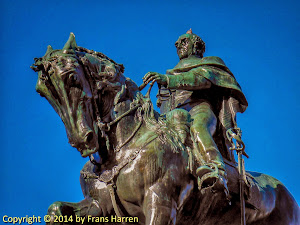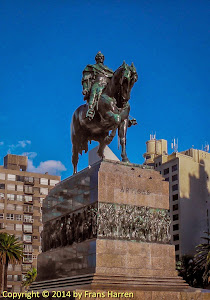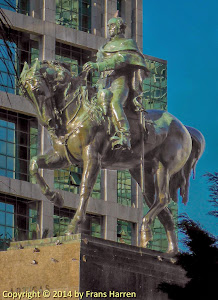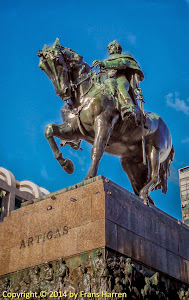Artigas Mausoleum
The Artigas Mausoleum is a monument to Uruguayan hero José Artigas, located in Plaza Independencia, in the neighbourhood of Ciudad Vieja, Montevideo. It was built in the 1930s and Artigas's remains are kept in an underground room underneath the statue. The moument is guarded by a traditional guard called "Blandegues de Artigas".
See: wikipedia
José Gervasio Artigas
José Gervasio Artigas Arnal (June 19, 1764 – September 23, 1850) is a national hero of Uruguay, sometimes called "the father of Uruguayan nationhood". His portrait is on the watermark on the 1998 Uruguay 5 Pesos Uruguayos banknote.
Early life
Artigas was born in Montevideo on June 19, 1764. His grandparents were from Zaragosa, Buenos Aires and Tenerife (Canary Islands). His grandparents fought in the War of the Spanish Succession and moved to the Americas to escape from poverty, settling in Buenos Aires in 1716. Artigas was the son of Martín José Artigas and Francisca Antonia Arnal, who came from a wealthy family. His parents enrolled him in the Colegio de San Bernardino, to pursue religious studies, but Artigas refused to submit to the school's strict discipline. Before he left the school, he developed a strong friendship with Fernando Otorgues, who would work with him in later years. At the age of 12, he moved to the countryside and worked on his family's farms. His contact with the customs and perspectives of gauchos made a great impression on him. Once he had come of age, he distanced himself from his parents and became involved in cattle smuggling. This made him a wanted man among the owners of haciendas and with the government in Montevideo. A reward was put out for his death.
Things changed with the opening of the Anglo-Spanish War, and the threat of a British attack upon the viceroyalty. The viceroy Antonio de Olaguer y Feliú negotiated a pardon with his family, on the condition that he joined the Corps of Blandengues with a hundred men, to form a battalion. Thus, he began his military career in 1797, at age 33, with the rank of lieutenant. The attack finally came in 1806, when William Beresford invaded Buenos Aires, in the first British invasions of the Río de la Plata. Although Artigas's unit was tasked with patrolling the frontier with Brazil, he requested to take part in the military expedition that Santiago de Liniers launched from Montevideo to drive the British out of Buenos Aires. His request was granted, and the British were defeated. After the liberation of Buenos Aires, he was tasked with returning to Montevideo and informing the governor Pascual Ruiz Huidobro of the result of the battle. A second British attack aimed to capture Montevideo, which was captured in the Battle of Montevideo. Artigas was taken prisoner, but he managed to escape and returned to the countryside. He organized groups of gauchos and began a guerrilla war against the invaders. The British tried to capture Buenos Aires a second time, but were defeated by the local armies, and returned Montevideo to Spanish control as part of the terms of capitulation. Artigas was promoted to captain in 1809.
Oriental revolution
The ideas of the Age of Enlightenment and the outbreak of the Peninsular War in Spain, along with the capture of King Ferdinand VII, generated political turbulence all across the Spanish Empire. The absence of the king from the throne (replaced by the French Joseph Bonaparte) and the new ideas of the Enlightenment sparked the Spanish American wars of independence, between patriots (who wanted to establish republics or constitutional monarchies) and royalists (who wanted to keep an absolute monarchy). Artigas, who thought that the gauchos were not treated well, supported the new ideas. Buenos Aires deposed the viceroy in 1810, during the May Revolution, replacing him with the Primera Junta. Mariano Moreno, secretary of war, wrote at the Operations plan that Artigas would be a decisive ally against the royalists in Montevideo, and called him for an interview. However, by the time Artigas arrived in Buenos Aires, Moreno had already left the government. He was still welcomed, but received little help. He was promoted to colonel and received some weapons, money and 150 men, very little to organize a rebellion at the Banda Oriental. This was the last time Artigas saw the city of Buenos Aires.
Spain declared Buenos Aires a rogue city, and appointed Montevideo as the new capital, with Francisco Javier de Elío as the new viceroy. The city had financial problems, and the measures taken by Elío to maintain the royalist armies were highly unpopular in the countryside. This allowed Artigas to channel the popular discontent against the colonial authorities. A hundred men met near the Asencio stream and made the cry of Asencio, a pronunciamiento against the viceroy. They captured many villages in the Banda Oriental, such as Mercedes, Santo Domingo, Colla, Maldonado, Paso del Rey, Santa Teresa and San José. They also captured Gualeguay, Gualeguaychú and Arroyo de la China, at the west of the Uruguay river.
Elío sent some soldiers to kill Artigas, who failed. Then, he sent Manuel Villagrán, a relative of Artigas, to offer him the pardon and appoint him general and military leader of the Banda Oriental if he gave up the rebellion. Artigas considered the offer an insult, and sent Villagrán prisoner to Buenos Aires.
Montevideo was soon surrounded by Artigas's forces. A Montevidean army tried to stop the patriots at the Battle of Las Piedras, but they were defeated, and the city was put to siege. José Rondeau, commanding forces from Buenos Aires, joined the siege. Artigas wanted to attack the city right away, but Rondeau thought that there would be less loss of lives by establishing a blockade and waiting for the city to surrender. However, the besiegers did not consider the naval forces of Montevideo, who kept the city supplied and enabled them to endure the blockade.
On the verge of defeat, Elío allied himself with Brazilian forces, requesting their intervention in the conflict. Dom Diogo de Sousa entered into the Banda Oriental, leading an army of five thousand men. This added to the defeat of Manuel Belgrano at the Paraguay campaign, the defeat of Juan José Castelli at the First Upper Peru campaign and the Montevidean naval blockade of Buenos Aires. Fearing a complete defeat, Buenos Aires signed a truce with Elío, recognizing him as the ruler of the Banda Oriental and half of Entre Ríos. Artigas felt the truce to be treasonous. He broke relations with the city, and lifted the blockade over Montevideo.
Artigas left the Banda Oriental and moved to Salto Chico, in Entre Ríos. All his supporters moved with him. This massive departure is known as the Oriental exodus.
The Supreme Director Gervasio Antonio de Posadas offered a reward of $6.000 for the capture of Artigas, dead or alive. The only consequence of this action was increased resentment of the orientals towards Buenos Aires. Several royalist leaders, such as Vigodet or Pezuela, sought an alliance with Artigas against Buenos Aires, but he rejected them: "I may not be sold, nor do I want more reward for my efforts than to see my nation free from the Spanish rule". Despite the deep disputes, Artigas was still eager to return to good terms with Buenos Aires, but only if the city accepted a national organization based on federalist principles.
Posadas sent two more armies to capture and execute Artigas, but they mutinied and joined the orientals. When the Artiguist influence expanded to Corrientes, Posadas sought to negotiate by accepting the autonomy of the provinces. Artigas accepted the terms, but clarified that such autonomy must not be understood as national independence. He did not want to secede the Banda Oriental from the United provinces, but to organize them as a confederation. Posadas, who supported the authority of Buenos Aires as the head of a centralized state, delayed the approval of the treaty.
Buenos Aires renewed the military actions against Montevideo. This time, the naval skills of William Brown helped to overcome the strength of the Montevidean navy, leading to the final defeat of the royalist stronghold. Carlos María de Alvear led the capture of Montevideo, and lured Artigas there by promising that he would turn over the city to the Oriental patriots. Alvear attacked them without warning at Las Piedras, but Artigas managed to escape from the trap.
Liga Federal
In 1814, Artigas organized the Liga de los Pueblos Libres (League of the Free Peoples), of which he was declared Protector. In the following year, he liberated Montevideo from the control of the "Unitarians" from Buenos Aires.
In 1815, Artigas attended the Proto-congress of the Independence of Argentina, held in Arrollo de la China (today known as Concepción del Uruguay). It was at this congress that the provinces of the Oriental Province (today the country of Uruguay), Córdoba, Corrientes, Entre Ríos, Misiones and Santa Fe declared themselves independent from Spain and formed the Liga Federal ("Federal League"). The Liga Federal invited other provinces of the former Viceroyalty of the Rio de la Plata to join them under a federal system.
In this congress, Artigas ratified the use of the flag created by Manuel Belgrano (which would later become the flag of the Argentine Republic), but added a diagonal festoon in red, the color of federalism in Argentina at that time.
Luso Brazilian invasion
The continued growth of influence and prestige of the Federal League frightened the governments in Buenos Aires (because of its federalism) and Portugal (because of its republicanism), and in August 1816, Portugal invaded the Eastern Province (with tacit complicity from Buenos Aires), with the intention of destroying Artigas and his revolution.
The Portuguese forces, led by Carlos Frederico Lecor, captured Artigas and his deputies and occupied Montevideo on 20 January 1817, but the struggle continued for three years in the countryside. Infuriated by Buenos Aires's passivity, Artigas declared war on Buenos Aires while he was losing to the Portuguese. His subordinates, members of the Federal League -- Francisco Ramírez, governor of Entre Ríos, and Estanislao López, governor of Santa Fe—managed to defeat the centralism of Buenos Aires. But hope for a new nation was short-lived; both commanders entered agreements with Buenos Aires that went against the principles of Artigas. They rebelled against him and left him to be crushed by the Portuguese.
Without resources and men, Artigas withdrew to Paraguay in September 1820. In Paraguay, Dr. Francia, the dictator, banished him to Candelaria. He then disappeared from the political life of the region. (B. Nahum).
After a long exile, he died in Paraguay in 1850, at age 86. It is said that Artigas, feeling himself to be near death, asked for a horse and died in the saddle, as a gaucho. His remains were buried and then re-interned at the Panteón Nacional in 1855. On the 19th of June, 1977, his remains were transferred to the Artigas Mausoleum in the centre of the Plaza Independencia.
See: wikipedia

















0 comments:
Post a Comment